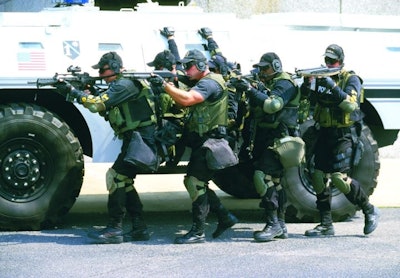 Photo: POLICE file art.
Photo: POLICE file art.
Speed and quick movement are the critical components of dynamic entry. This tactic is meant to surprise and overwhelm the suspect(s), and thereby prevent them from taking up arms, hardening their defensive position, harming hostages or destroying evidence.
In other words, we're going to use speed, surprise and violence of action to stop the bad guys from grabbing a gun, locking the door, harming innocents or flushing the dope.
Situational assessment is difficult on the fly. Moving slower or setting up containment gives us a chance to establish solid intelligence. Valuable information such as where the guy with the gun is concealed helps. Assessing the situation is tougher when you're moving rapidly. And you may ask if there is even anybody inside the target.
There are times when dynamic entry may be the only option available. There are other options at our disposal that need to be considered before we breach a door, throw a flash-bang and roll into dark territory.
Here's a scenario to consider. It's based on an actual incident.
The homicide-assault unit has contacted the tactical commander. They have a no-knock search warrant, signed by a judge, in hand. The warrant is for a felony assault suspect and his weapon, a large single-action revolver.
The suspect is a member of an outlaw biker gang. Numerous arrests and convictions for narcotics offenses and violent crimes, including a term in the penitentiary for murder two, appear on his record. He beat his estranged wife to death with a toilet seat. Most recently — the crime he is accused of — he stuck the barrel of this large revolver in the mouth of a juvenile and threatened to kill him.
The suspect lives by himself in a single-family home in a blue-collar neighborhood. The warrant will be served at approximately 11:30 p.m. on a Tuesday. Ambient temperature is in the 20s. Lights are on in the living room. The suspect's vehicle is at the residence. Homicide detectives have been sitting on the house, waiting for our arrival. They've observed no one coming or going.
We have the signed no-knock. Do we serve it by initiating a dynamic entry? Or do we explore other options to take the suspect into custody and secure the evidence (revolver)?
What would you do? Please give us your answer, by adding a comment below. Articulate your reasons for the option you choose.
In the next column, I'll tell you how the scenario actually went down, as well as the aftermath.




















